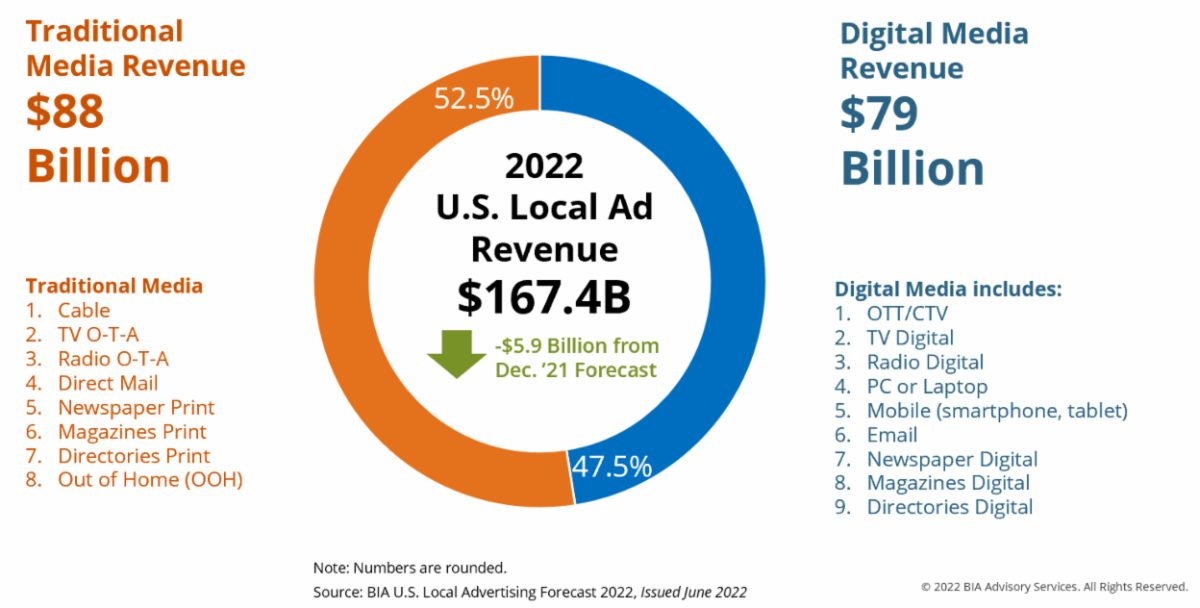BIA Lowers 2022 Local Ad Estimates
Headwinds from overseas conflicts, continuing supply chain issues and deep cuts in ad spending from large verticals like automotive prompted the reduced estimates

CHANTILLY, Va.—BIA Advisory Services has decreased its 2022 U.S. Local Advertising Forecast estimate to $167.4 billion, a decline from its original estimate of $173.3 billion issued in December 2021.
But it is still predicting hefty growth for TV over-the-air (OTA) spending, which is set to see a +30.3% pop in 2022. and TV digital, which is set to grow 18.3%.
Headwinds from overseas conflicts, continuing supply chain issues and deep cuts in ad spending from large verticals like automotive prompted them to revise their overall estimates for local TV advertising downwards, BIA said.
Despite those problems, BIA also highlighted some positive trends for the ad market, including an anticipated strong political ad year, the expansion of online gambling local advertising and consumer spending on leisure and recreational activities.
“The year didn’t start as strong as we had anticipated, making for a difficult first two quarters as some expected advertising spend started to retract,” said Mark Fratrik, senior vice president and chief economist, BIA Advisory Services. “On the one hand, personal income continues to rise, but the cost of consumer goods, rising gas prices and inflation are having a major impact and we believe that will influence how advertisers will choose to use their ad dollars in the coming months. All of that must be weighed against what we see as positives for local advertising this year.”
The latest forecast still gives traditional media ad revenue a slight advantage over digital at 52.5% of the ad spend ($87.9 billion), while digital media will get 47.5% of the ad spend at $79.5 billion, BIA reported.
Overall, BIA is decreasing digital estimates slightly from the original 2022 forecast due to mobile facing headwinds amid new privacy measures on iPhones. Additionally, there has been slower than anticipated growth. Even as both digital channels continue to grow, it’s at a reduced pace than originally expected.
The professional video industry's #1 source for news, trends and product and tech information. Sign up below.
Other key data from the report includes:
- The top three paid media channels for 2022 include Direct Mail ($34 billion), Mobile ($32 billion), and PC/Laptop ($30 billion).
- Over-the-top (OTT) is still slated to be the fastest-growing (57.4% in 2022).
- Significant growth is expected in TV OTA (+30.3%), TV Digital (+18.3%) and Radio Digital (+14.5%).
- Tier 1 - Automotive Manufacturers (OEMs) has been adjusted down by 17.6% to $3.9 billion (was $4.7 billion). Overall, for the entire automotive industry, BIA lowered the updated ad estimates by $1.4 billion for a total of $12.4 billion. That still indicates some growth from 2021, 5.5%, but significantly down from original estimates.
- Leisure areas like Airport, Cruises, and Other Travel; Fitness and Recreational Sports Centers; and Museums, Historical Sites, and other venues are all experiencing significant growth in ad spending from last year to this year. Pent-up demand for travel and entertainment are driving growth in these areas but may be tempered by late summer due to inflation and other economic concerns.
- Local political advertising spending was raised to $8.6 billion with local television getting a large share of the spend.
BIA’s vice president of forecasting and analysis, Nicole Ovadia, added that “We are seeing the economy play out in local advertising. For instance, people saved money during the pandemic and now, are enjoying different areas in the leisure and recreational verticals. People are spending on vacations and activities, and even going back to the gym. In all these areas, including political, we increased local advertising expectations. For businesses that have a direct reliance on supply chains, we have lowered expectations and will continue to monitor the situation throughout the summer fully expecting we may have to revise our estimates because the economy is in such a state of flux.”
George Winslow is the senior content producer for TV Tech. He has written about the television, media and technology industries for nearly 30 years for such publications as Broadcasting & Cable, Multichannel News and TV Tech. Over the years, he has edited a number of magazines, including Multichannel News International and World Screen, and moderated panels at such major industry events as NAB and MIP TV. He has published two books and dozens of encyclopedia articles on such subjects as the media, New York City history and economics.

